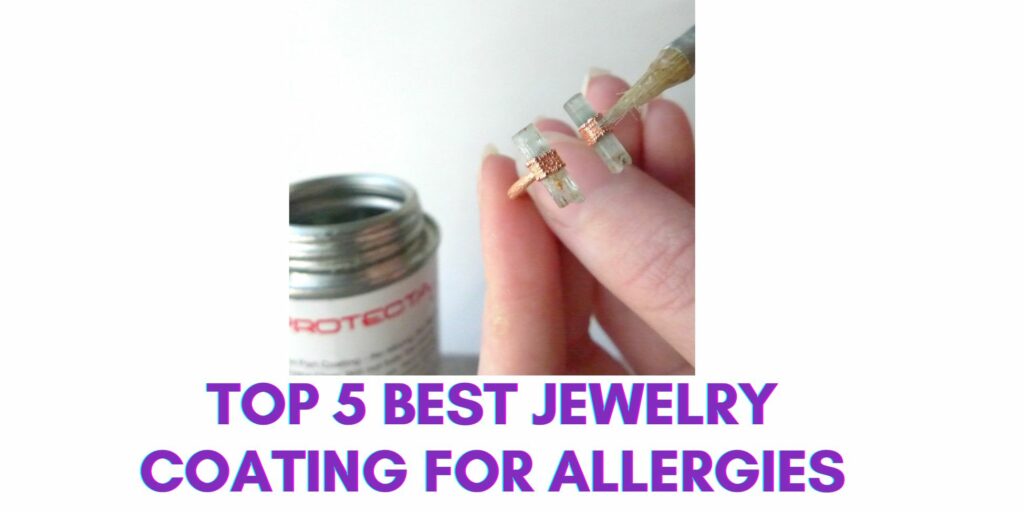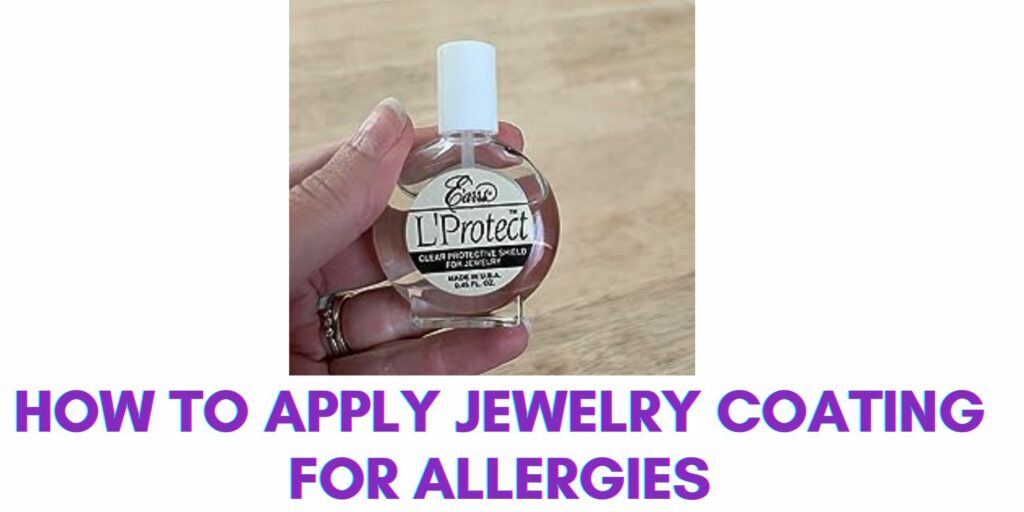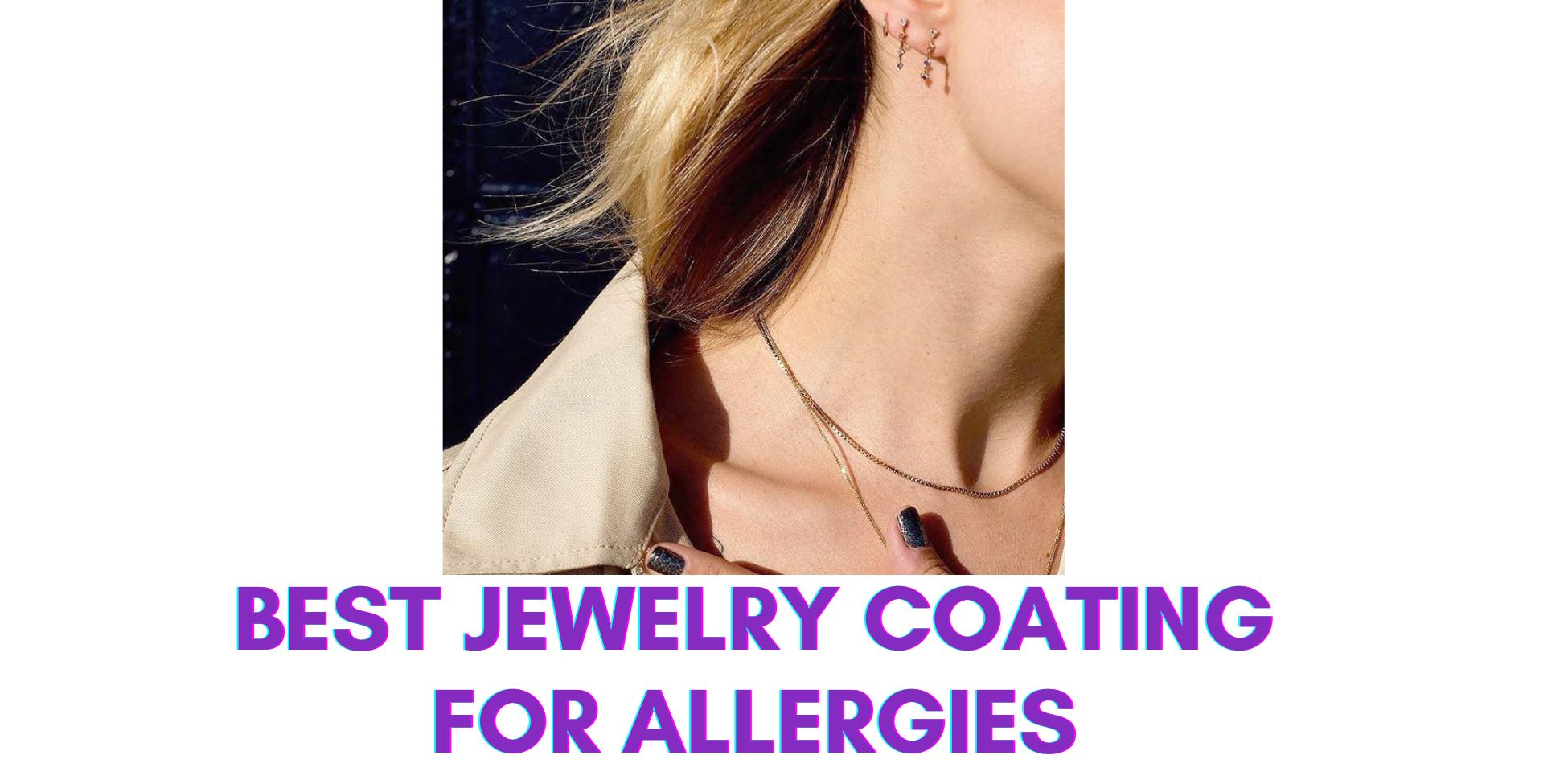Are you tired of saying goodbye to your favorite jewelry pieces due to annoying skin allergies?
You’re not alone!
As someone who’s been there, I had to find myself coatings or opt for Hoop Earrings for Sensitive Ears that won’t leave you itching or with an unsightly rash.
In this post, I’ll share the 5 Best Jewelry Coating for Allergies that are kind to your skin.
- Top 5 Best Jewelry Coating for Allergies
- Best Jewelry Coating for Allergies Comparison Table
- Types of Jewelry Coating for Allergies
- Factors to Consider When Choosing the Best Jewelry Coating for Allergies
- Ultimate Guide to Allergy-Free Jewelry Coating
- How to Apply Jewelry Coating for Allergies
- Benefits of Hypoallergenic Jewelry Coating
- FAQs on the Best Jewelry Coating for Allergies
- Conclusion
Top 5 Best Jewelry Coating for Allergies

These are the top 5 best jewelry coating for allergies:
1. ProtectaClear
ProtectaClear is a nickel-free, non-toxic coating designed to protect against irritation. Its resistance to water and protection from tarnishing ensure prolonged wear without compromise.
2. Eternal Jewelry Coating
Elevate your daily wear with Eternal Jewelry Coating, which enhances scratch resistance and defense against yellowing. Its durable, non-toxic formula makes it a secure and stylish option for those with jewelry sensitivities.
3. Jewelry Shield
Jewelry Shield forms a robust barrier that prevents allergic reactions by creating a protective layer between the metal and your skin. Its user-friendly application makes it the preferred choice for reliable and hassle-free protection.
4. L’Protect Jewelry Protective Coating
It is formulated with hypoallergenic resins, creating a transparent, non-toxic shield against metal allergens. Its water and sweat resistance ensures lasting protection, meeting the needs of allergy-conscious wearers.
5. Nickel Guard
Nickel Guard is specially designed for individuals with nickel allergies and is an effortless solution that shields against nickel exposure, effectively reducing the risk of dermatitis.
You can also try making earrings yourself and avoid specific materials that can cause you irritation. Check out my guide on How to Make Custom Earrings to learn more.
Best Jewelry Coating for Allergies Comparison Table
This table compares the best jewelry coating for allergies:
| Features | ProtectaClear | Eternal Jewelry | Jewelry Shield | L’Protect Jewelry Protective Coating | Nickel Guard |
|---|---|---|---|---|---|
| Type of Coating | Clear, one-part coating | Clear coating | Transparent coating | Clear, brush-on coating | Transparent |
| Application Method | Brush Application | N/A | Brush application | Brush application | N/A |
| Resistance | Corrosion-resistant, scratch and abrasion-resistant | Water and dust repellent | Protects against allergic reactions | Creates a barrier between metal and skin | N/A |
| Ease of Maintenance/Removal | Easy to maintain or remove and re-coat | Easy-to-clean surface | Lasts three months | It can be removed with nail polish remover | Can be re-tested with Nickel Alert |
| Drying Time | Dries quickly, no residual smell after 1 hour | At least 5 minutes | 20 minutes | At least 30 minutes | Dries Easily |
| Removal Method | Methylated Spirits | N/A | Nail polish remover | Nail polish remover | N/A |
Once you’ve chosen a hypoallergenic coating from the options above, why not treat yourself to our Cute Earring Sets for 3 Holes collection?
Types of Jewelry Coating for Allergies
These are the types of jewelry coating for allergies:
- Rhodium Plating: Rhodium is often used on white gold and sterling silver. It creates a surface that’s not only hypoallergenic but also resistant to tarnishing.
- Gold Plating: Gold plating commonly applies a protective layer to various base metals. This layer helps reduce the risk of allergic reactions, making it a popular choice.
- Palladium Coating: When coating metals like white gold, palladium provides a durable, hypoallergenic, and tarnish-resistant layer, making it an ideal choice for enhancing jewelry quality.
- Titanium Nitride Coating: When applied to metals like stainless steel, titanium nitride coating brings about exceptional durability, corrosion resistance, and hypoallergenic properties, ensuring a longer-lasting piece.
- Black Rhodium Plating: Black rhodium plating is applied to various metals to maintain a hypoallergenic layer, offering aesthetic appeal and skin-friendliness. It introduces a stylish black finish.
- Ceramic Coating: Crafted from ceramic materials, this coating is applied to metal or used in jewelry for its hypoallergenic, lightweight, and scratch-resistant qualities, contributing to comfort and durability.
- E-Coating (Electrophoretic Coating): E-coating incorporates various materials like polymers and is carefully applied through an electrochemical process. This results in a durable and hypoallergenic protective layer, enhancing the longevity of the jewelry.
- Enamel Coating: Composed of glass-based enamel, this coating is delicately applied to metals, especially in decorative pieces. It provides a burst of color and ensures a hypoallergenic surface for the wearer’s comfort.
- Nano-Coating: Also referred to as ceramic coating, nano-coating involves applying a layer that repels particles, water, oil, and dirt. This versatile coating, whether in liquid or solid form, offers beneficial characteristics, enhancing the functionality of the jewelry piece.
For insights on the debate around double ear piercings, check out our article Are Double Ear Piercings Trashy?
Factors to Consider When Choosing the Best Jewelry Coating for Allergies
These are the factors to consider when choosing the best jewelry coating for allergies:
- Hypoallergenic Materials: Prioritize coatings made from materials that are less likely to cause allergic reactions.
- Durability: Evaluate the longevity of the coating to ensure it withstands everyday wear without compromising its integrity.
- Skin Sensitivity: Assess the potential for skin irritation by opting for coatings specifically designed for individuals with allergies.
- Lifestyle Compatibility: Consider the wearer’s lifestyle to choose a coating that suits their daily activities without causing discomfort.
- Ease of Maintenance: Choose coatings that are easy to clean and maintain, as proper care contributes to prolonged wear without aggravating allergies.
- Allergen Testing: Opt for coatings that have undergone allergen testing, ensuring a higher level of safety for those with sensitivities.
- Customer Reviews: Explore feedback from individuals with similar allergies to gauge the effectiveness of the coating in real-world scenarios.
Ultimate Guide to Allergy-Free Jewelry Coating
Follow these steps to ensure you can enjoy wearing earrings without the worry of allergic reactions:
- Choose Hypoallergenic Materials: Start by selecting earrings made from materials known to be hypoallergenic, such as titanium, platinum, or 14k gold.
- Apply a Protective Coating: Use a product like ProtectaClear on any earrings that are not made of these materials. This creates a barrier between the metal and your skin.
- Test the Earrings: Before committing to a full day of wear, test the earrings for a short period to ensure there is no reaction.
- Maintain Good Hygiene: Keep both your earrings and your earlobes clean to prevent any irritation or infection.
- Enjoy Your Allergy-Free Accessories: With these steps, you can confidently wear beautiful earrings without the fear of allergic reactions.
For a touch of nature’s elegance, explore our Lake Tahoe Necklace Collection, where each piece reflects the serene beauty of this beloved landscape.
How to Apply Jewelry Coating for Allergies

These are the steps to apply jewelry coating for allergies:
- Preparation: Begin the process in a well-ventilated area to minimize exposure and ensure the jewelry is clean and free from contaminants.
- Protective Measures: Wear gloves to shield your skin from direct contact with the coating, and consider using a mask if applying the coating in an enclosed space.
- Read Instructions Thoroughly: Familiarize yourself with the specific instructions provided by the coating manufacturer, and note any precautionary measures mentioned.
- Application Process: Apply a thin, even coating layer using a designated applicator or brush, ensuring complete coverage on all jewelry surfaces.
- Allow for Drying: Follow the recommended drying time specified by the manufacturer, and keep the jewelry in a dust-free environment while it dries.
- Evaluate Results: Inspect the coated jewelry for uniformity and coverage, addressing any uneven coating or imperfections if necessary.
- Repeat if Needed: Depending on the product, consider applying additional coats for enhanced protection and allow sufficient drying time between each application.
- Post-Application Care: Store the coated jewelry clean and dry, regularly inspecting and reapplying the coating as needed.
- Monitor Skin Reaction: Wear the coated jewelry for short durations initially, observing for any adverse reactions, and adjust accordingly to ensure a comfortable experience.
Benefits of Hypoallergenic Jewelry Coating
These are the benefits of jewelry coating for allergies:
- Keeps Allergies Away: The coating acts like a shield between your skin and the metal in the jewelry, stopping them from touching. This helps greatly if you’re allergic to metals like nickel, making your jewelry comfier.
- Customized Protection: You can pick a coating that matches the metal bothering your skin. This way, you can wear a bunch of different jewelry without having any allergic reactions. It’s like a personal guard for your skin!
- Less Skin Troubles: Coatings stop your skin from getting irritated, meaning no redness or itching. It lets you enjoy your jewelry without discomfort, making showing off your favorite pieces easier.
- Fits Many Types of Jewelry: You can use coatings on many different metals, making them great for people allergic to all sorts of things. This means you have more options for jewelry that won’t bother your skin.
- Keeps Jewelry Looking Good: The coating stops jewelry from changing colors or getting messed up. This helps your jewelry look brand new, like when you first got it.
- Wear Your Jewelry Longer: With the coating protecting your skin, you can wear your favorite jewelry for a long time without any problems. It makes your jewelry more comfortable, so you can wear it whenever possible.
- Easier to Take Care Of: Coatings make taking care of your jewelry easier. You don’t have to clean or polish it as much because the coating protects it from things that might mess it up.
- Stay Stylish Without Worry: Coatings let you try out all the latest jewelry trends without stressing about allergies. You can look great and feel great, all thanks to the protection of these coatings.
Unleash your creativity with our Earring Ideas for 3 Holes collection, where you’ll find unique designs to beautifully accentuate your triple piercings.
FAQs on the Best Jewelry Coating for Allergies
These are the most frequently asked questions about the best jewelry coating for allergies:
What Is the Best Jewelry Coating for Allergies?
ProtectaClear is the best jewelry coating for allergies.
Can Any Coating Prevent All Types of Metal Allergies?
While no coating can guarantee the prevention of all metal allergies, choosing a hypoallergenic coating that matches your specific allergen, combined with proper care, can significantly reduce the risk of allergic reactions.
Is It Safe to Apply Jewelry Coatings Myself?
Yes, Jewelry coatings are designed for at-home application.
How Long Does a Jewelry Coating Last?
A well-applied jewelry coating can last for several months to years.
Conclusion
Selecting the best jewelry coating for allergies is crucial for comfort and style. Hypoallergenic coatings offer a protective shield, minimizing allergic reactions. Consider individual sensitivities, durability, and ease of application to find the best jewelry coating for allergies, ensuring safety and aesthetic appeal.

